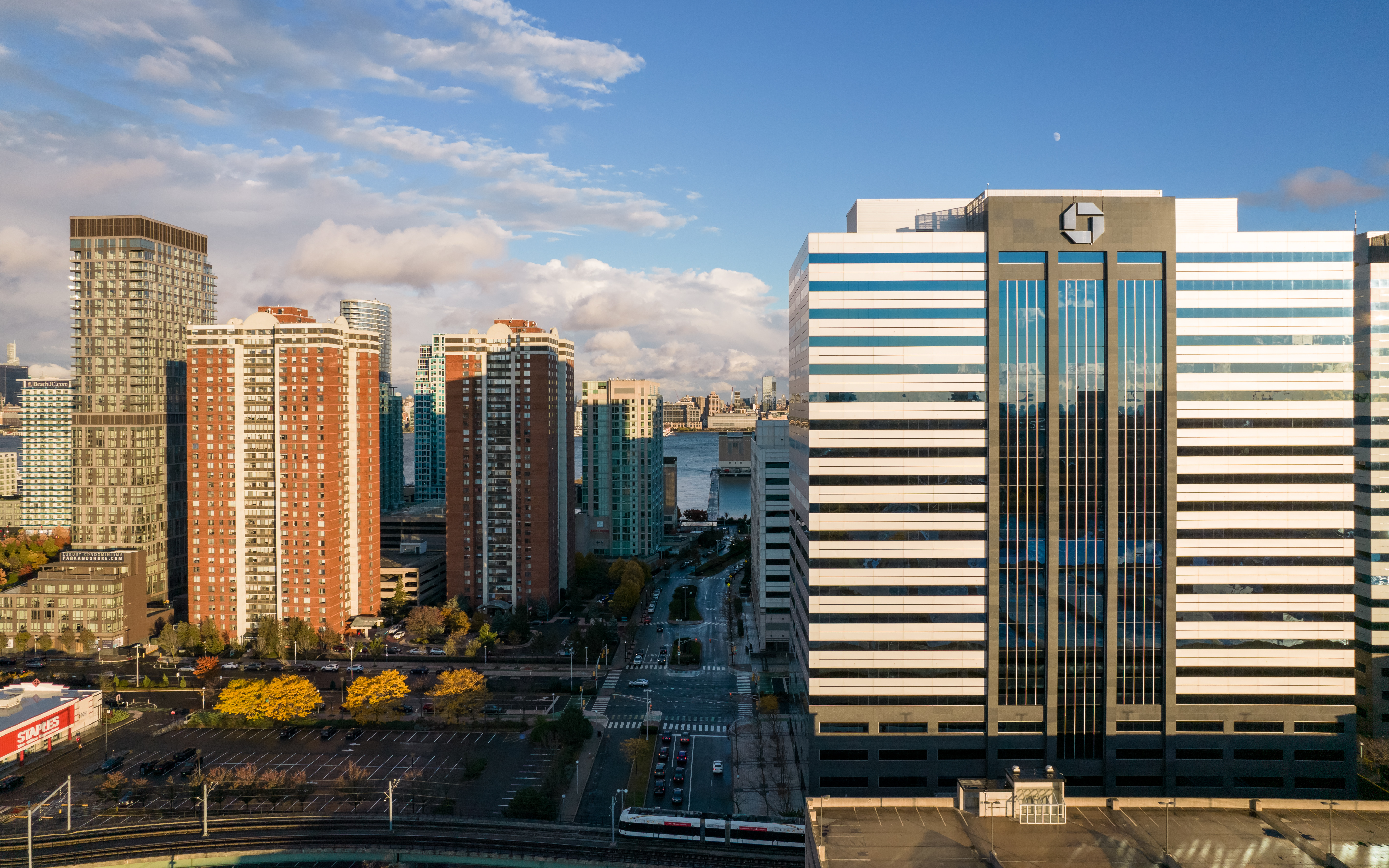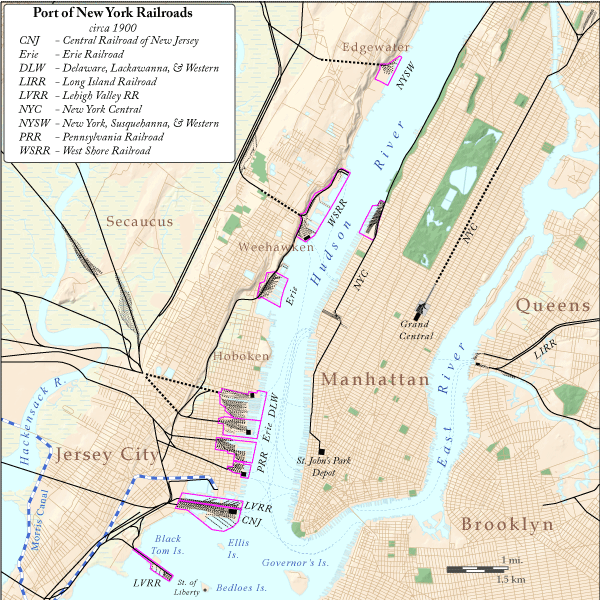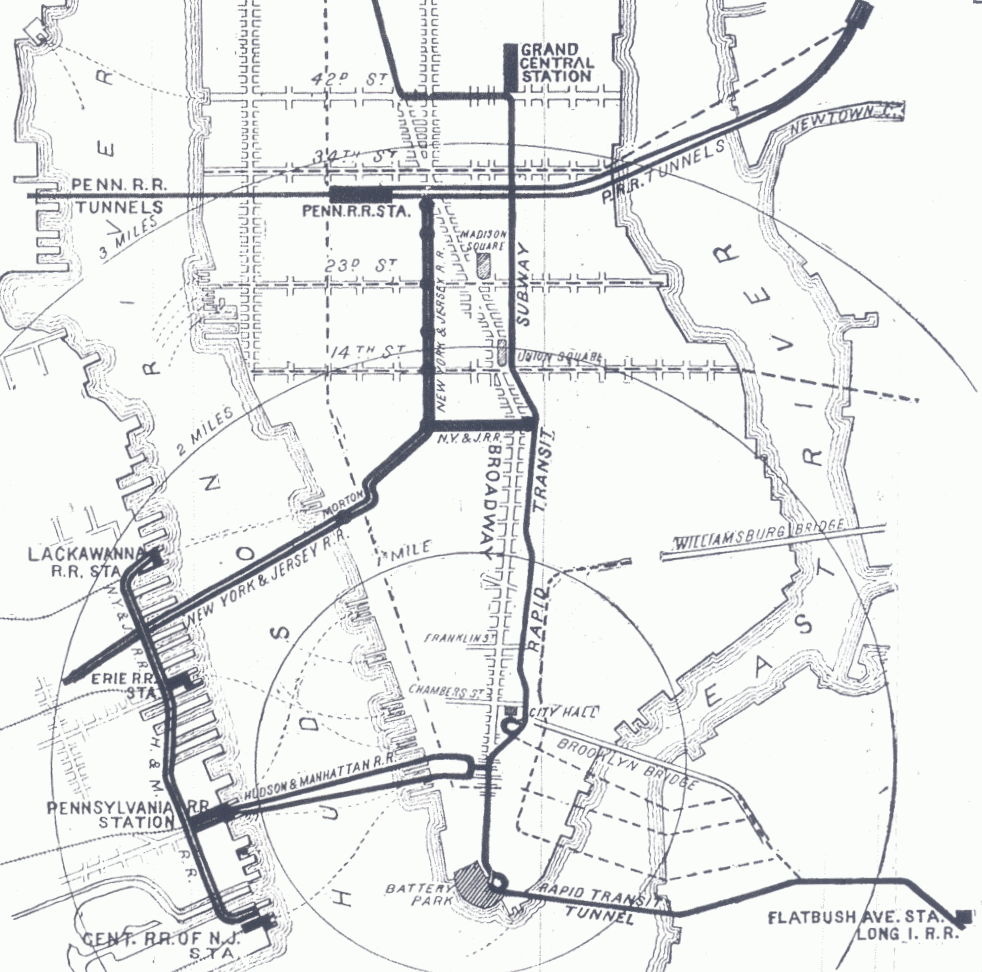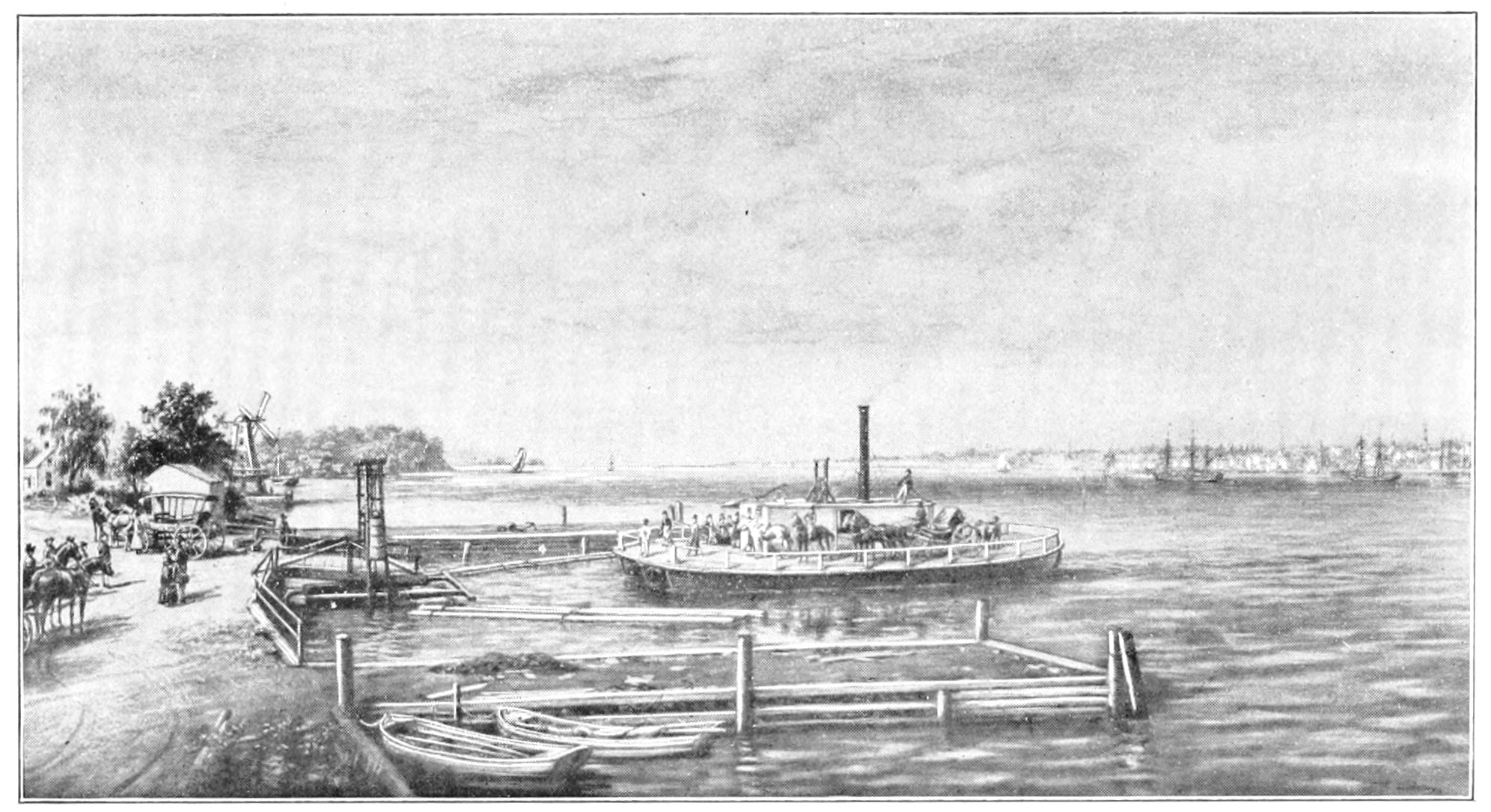|
Pavonia Terminal
Pavonia Terminal was the Erie Railroad terminal on the Hudson River situated on the landfilled Harsimus Cove in Jersey City, New Jersey. The station opened in 1861 and closed in 1958 when the Erie Railroad moved its passenger services to nearby Hoboken Terminal. The New York, Susquehanna and Western Railway also ran commuter trains from the terminal and various street cars, ferries and the underground Hudson and Manhattan Railroad serviced the station. The station was abandoned in 1958 and demolished in 1961. The site was eventually redeveloped into the Newport district in the late 20th century. Pavonia was one of five passenger railroad terminals that lined the western shore of the Hudson Waterfront from the mid-19th to mid-20th centuries, along with those at Weehawken, Hoboken, Exchange Place, and Communipaw, with Hoboken being the only one still in service. History The Erie began developing the waterfront site in 1856. The intermodal complex was open December 4, 1887. Acro ... [...More Info...] [...Related Items...] OR: [Wikipedia] [Google] [Baidu] |
Harsimus Cove
Harsimus (also known as Harsimus Cove) is a neighborhood within Downtown Jersey City, Hudson County, New Jersey, United States. The neighborhood stretches from the Harsimus Stem Embankment (the Sixth Street Embankment) on the north to Christopher Columbus Drive on the south between Coles Street and Grove Street or more broadly, to Marin Boulevard. It borders the neighborhoods of Hamilton Park to the north, Van Vorst Park to the south, the Village to the west, and the Powerhouse Arts District to the east. Newark Avenue has traditionally been its ''main street''. The name is from the Lenape, used by the Hackensack Indians who inhabited the region and could be translated as ''Crow’s Marsh''. From many years, the neighborhood was part of the "Horseshoe", a political delineation created by its position between the converging rail lines and political gerrymandering. Early settlement Harsimus is a derivative of a Lenape phrase, possibly meaning ''Crow's Marsh''. Spellings inclu ... [...More Info...] [...Related Items...] OR: [Wikipedia] [Google] [Baidu] |
Newport, Jersey City
Newport is a master-planned, mixed-use community in Downtown Jersey City, New Jersey, United States, consisting of retail, residential, office, and entertainment facilities. The neighborhood is situated on the Hudson Waterfront on what had been the yards of Erie Railroad's Pavonia Terminal, located opposite Lower Manhattan and the neighborhood of Tribeca in New York City. Redevelopment of the neighborhood began in 1986 as a $10 billion project led by real-estate tycoon Samuel J. LeFrak and his firm The LeFrak Organization. History Newport's name was changed from "Newport City" to just "Newport" in 1988. Transportation The Hudson-Bergen Light Rail's Newport station and the PATH's Newport station are located in Newport. The area is also served by several New Jersey Transit bus lines, A&C Bus Corporation as well as other private bus lines. Interstate 78 is nearby and connects to the Holland Tunnel, which provides vehicle access to lower Manhattan, as well as to the New Jers ... [...More Info...] [...Related Items...] OR: [Wikipedia] [Google] [Baidu] |
Bergen Hill
Bergen Hill refers to the lower Hudson Palisades in New Jersey, where they emerge on Bergen Neck, which in turn is the peninsula between the Hackensack and Hudson Rivers, and their bays. In Hudson County, it reaches a height of 260 feet. Rail Defining features of Bergen Hill include the 19th century and early 20th century railroad rights-of-way. Cuts and tunnels created to provide access to the terminals and ferries on the North River (Hudson River) and Upper New York Bay, and eventually under the river. From south to north they are: * The Central Railroad of New Jersey lines traveled on the CRRNJ Newark Bay Bridge across Newark Bay and through Bayonne and Greenville to its Communipaw Terminal. Portions are used by the Hudson Bergen Light Rail. * The Jersey City, Newark and Western Railway (later the Lehigh Valley Terminal Railway) freight line on the bridge over Newark Bay and across Pamrapo is now used by CSX Transportation as the National Docks Secondary to Port Jersey a ... [...More Info...] [...Related Items...] OR: [Wikipedia] [Google] [Baidu] |
Port Authority Trans-Hudson
Port Authority Trans-Hudson (PATH) is a rapid transit system in the northeastern New Jersey cities of Newark, Harrison, Jersey City, and Hoboken, as well as Lower and Midtown Manhattan in New York City. It is operated as a wholly owned subsidiary of the Port Authority of New York and New Jersey. PATH trains run around the clock year round; four routes serving 13 stations operate during the daytime on weekdays, while two routes operate during weekends, late nights, and holidays. It crosses the Hudson River through cast iron tunnels that rest on the river bottom. It operates as a deep-level subway in Manhattan and the Jersey City/Hoboken riverfront; from Grove Street in Jersey City to Newark, trains run in open cuts, at grade level, and on elevated track. In , the system saw rides, or about per weekday in . The routes of the PATH system were originally operated by the Hudson & Manhattan Railroad (H&M), built to link New Jersey's Hudson Waterfront with New York City. The sys ... [...More Info...] [...Related Items...] OR: [Wikipedia] [Google] [Baidu] |
Rapid Transit
Rapid transit or mass rapid transit (MRT), also known as heavy rail or metro, is a type of high-capacity public transport generally found in urban areas. A rapid transit system that primarily or traditionally runs below the surface may be called a subway, tube, or underground. Unlike buses or trams, rapid transit systems are railways (usually electric railway, electric) that operate on an exclusive right-of-way (transportation), right-of-way, which cannot be accessed by pedestrians or other vehicles, and which is often grade-separated in tunnels or on elevated railways. Modern services on rapid transit systems are provided on designated lines between rapid transit station, stations typically using electric multiple units on rail tracks, although some systems use guided rubber tires, magnetic levitation (''maglev''), or monorail. The stations typically have high platforms, without steps inside the trains, requiring custom-made trains in order to minimize gaps between train a ... [...More Info...] [...Related Items...] OR: [Wikipedia] [Google] [Baidu] |
Streetcars
A tram (called a streetcar or trolley in North America) is a rail vehicle that travels on tramway tracks on public urban streets; some include segments on segregated right-of-way. The tramlines or networks operated as public transport are called tramways or simply trams/streetcars. Many recently built tramways use the contemporary term light rail. The vehicles are called streetcars or trolleys (not to be confused with trolleybus) in North America and trams or tramcars elsewhere. The first two terms are often used interchangeably in the United States, with ''trolley'' being the preferred term in the eastern US and ''streetcar'' in the western US. ''Streetcar'' or ''tramway'' are preferred in Canada. In parts of the United States, internally powered buses made to resemble a streetcar are often referred to as "trolleys". To avoid further confusion with trolley buses, the American Public Transportation Association (APTA) refers to them as "trolley-replica buses". In the United ... [...More Info...] [...Related Items...] OR: [Wikipedia] [Google] [Baidu] |
List Of Ferries Across The Hudson River In New York City
The following ferries once crossed the North River (Hudson River) between New York City and New Jersey. There was no ferry service between 1967 and 1989, when it was restarted by New York Waterway. Row and Sail Horse ferries Team boats served New York City for "about ten years, from 1814-1824. They were of eight horse-power and crossed the rivers in from twelve to twenty minutes." In 1812, two steam boats designed by Robert Fulton were placed in use in New York, for the Paulus Hook Ferry from the foot of Cortlandt Street, and on the Hoboken Ferry from the foot of Barclay Street. The ''Juliana'', running from Barclay Street, was withdrawn from service, as announced, in favor of the "more convenient" horse boat. It is almost certain, however, that this retrograde step was taken because of the monopoly enjoyed by Mssrs. Fulton and Livingston for the navigation of the waters of New York State by steam. Steam See also *List of ferries across the East River * List of ... [...More Info...] [...Related Items...] OR: [Wikipedia] [Google] [Baidu] |
George E
George may refer to: People * George (given name) * George (surname) * George (singer), American-Canadian singer George Nozuka, known by the mononym George * George Washington, First President of the United States * George W. Bush, 43rd President of the United States * George H. W. Bush, 41st President of the United States * George V, King of Great Britain, Ireland, the British Dominions and Emperor of India from 1910-1936 * George VI, King of Great Britain, Ireland, the British Dominions and Emperor of India from 1936-1952 * Prince George of Wales * George Papagheorghe also known as Jorge / GEØRGE * George, stage name of Giorgio Moroder * George Harrison, an English musician and singer-songwriter Places South Africa * George, Western Cape ** George Airport United States * George, Iowa * George, Missouri * George, Washington * George County, Mississippi * George Air Force Base, a former U.S. Air Force base located in California Characters * George (Peppa Pig), a 2-year-ol ... [...More Info...] [...Related Items...] OR: [Wikipedia] [Google] [Baidu] |
Pavonia, New Netherland
Pavonia was the first European settlement on the west bank of the North River (Hudson River) that was part of the seventeenth-century province of New Netherland in what would become the present Hudson County, New Jersey. Hudson and the Hackensack The first European to record exploration of the area was Robert Juet, first mate of Henry Hudson, an English sea captain commissioned by the Dutch East India Company. Their ship, the ''Halve Maen'' (''Half Moon''), ventured in the Kill van Kull and Newark Bay and anchored at Weehawken Cove during 1609, while exploring the Upper New York Bay and the Hudson Valley. By 1617 a ''factorij'', or trading post, was established at Communipaw. Others may have been established at Arresick or Hobokan Hackingh. Initially, these posts were set up for fur trade with the indigenous population. At that time the area was inhabited by bands of Algonquian language speaking peoples, known collectively as Lenni Lenape and later called the Delawares. Ea ... [...More Info...] [...Related Items...] OR: [Wikipedia] [Google] [Baidu] |
New York, Lake Erie And Western Railroad
The Erie Railroad was a railroad that operated in the northeastern United States, originally connecting New York City — more specifically Jersey City, New Jersey, where Erie's Pavonia Terminal, long demolished, used to stand — with Lake Erie, at Dunkirk, New York. It expanded west to Chicago with its 1865 merger with the former Atlantic and Great Western Railroad, also known as the New York, Pennsylvania and Ohio Railroad (NYPANO RR). Its mainline route proved influential in the development and economic growth of the Southern Tier of New York State, including cities such as Binghamton, Elmira, and Hornell. The Erie Railroad repair shops were located in Hornell and was Hornell's largest employer. Hornell was also where Erie's mainline split into two routes, one northwest to Buffalo and the other west to Chicago. On October 17, 1960, the Erie merged with former rival Delaware, Lackawanna & Western Railroad to form the Erie Lackawanna Railroad. The Hornell repair shops were c ... [...More Info...] [...Related Items...] OR: [Wikipedia] [Google] [Baidu] |
Intermodal Passenger Transport
Intermodal passenger transport, also called mixed-mode commuting, involves using two or more modes of transportation in a journey. Mixed-mode commuting is often used to combine the strengths (and offset the weaknesses) of various transportation options. A major goal of modern intermodal passenger transport is to reduce dependence on the automobile as the major mode of ground transportation and increase use of public transport. To assist the traveller, various intermodal journey planners such as Rome2rio and Google Transit have been devised to help travellers plan and schedule their journey. Mixed-mode commuting often centers on one type of rapid transit, such as regional rail, to which low-speed options (i.e. bus, tram, or bicycle) are appended at the beginning or end of the journey. Trains offer quick transit from a suburb into an urban area, where passengers can choose a way to complete the trip. Most transportation modes have always been used intermodally; for example, peo ... [...More Info...] [...Related Items...] OR: [Wikipedia] [Google] [Baidu] |
Central Railroad Of New Jersey Terminal
The Central Railroad of New Jersey Terminal, also known as Communipaw Terminal and Jersey City Terminal, was the Central Railroad of New Jersey's waterfront passenger terminal in Jersey City, New Jersey. The terminal was built in 1889, replacing an earlier one that had been in use since 1864. It operated until April 30, 1967. It also serviced the Central Railroad of New Jersey-operated Reading Railroad, the Baltimore and Ohio Railroad, and the Lehigh Valley Railroad during various periods in its 78 years of operation. The terminal was one of five passenger railroad terminals that lined the Hudson Waterfront during the 19th and 20th centuries, the others being Weehawken, Hoboken, Pavonia and Exchange Place, with Hoboken being the only station that is still in use, as of 2021. The headhouse was renovated and incorporated into Liberty State Park. The station has been listed on the New Jersey Register of Historic Places and National Register of Historic Places since September 12 ... [...More Info...] [...Related Items...] OR: [Wikipedia] [Google] [Baidu] |







.jpg)

